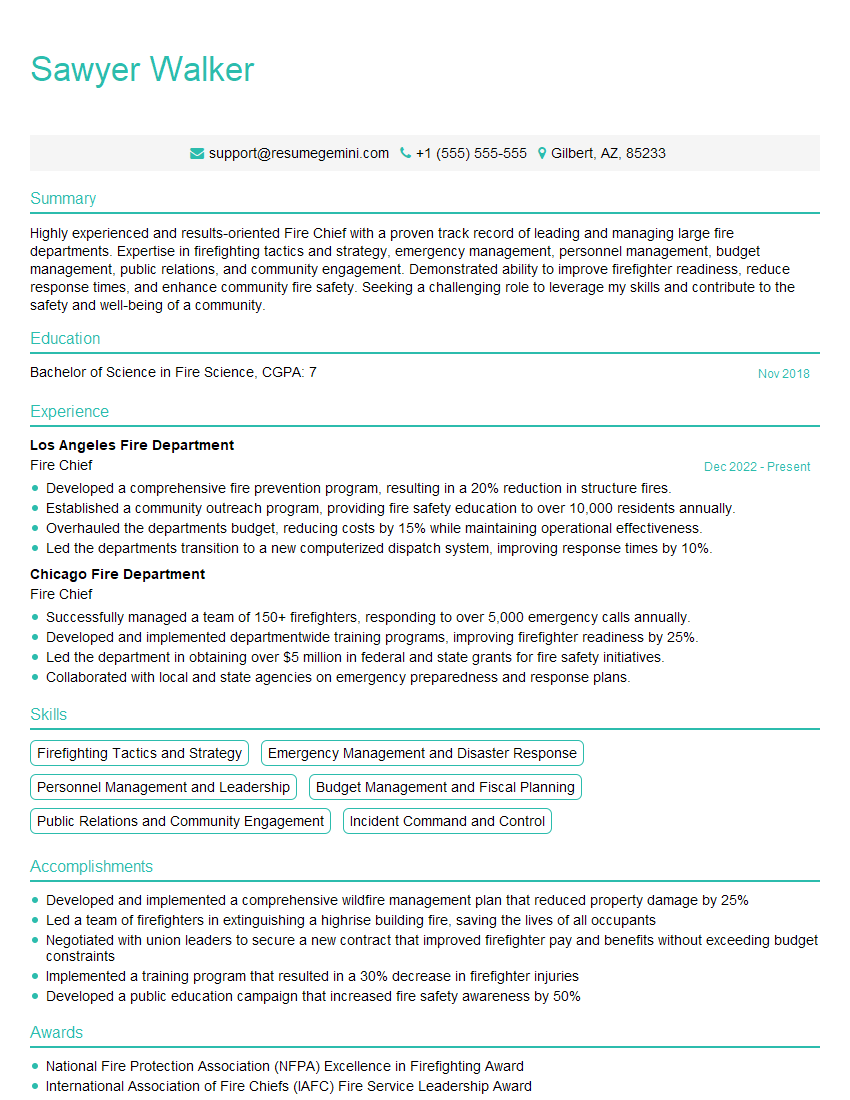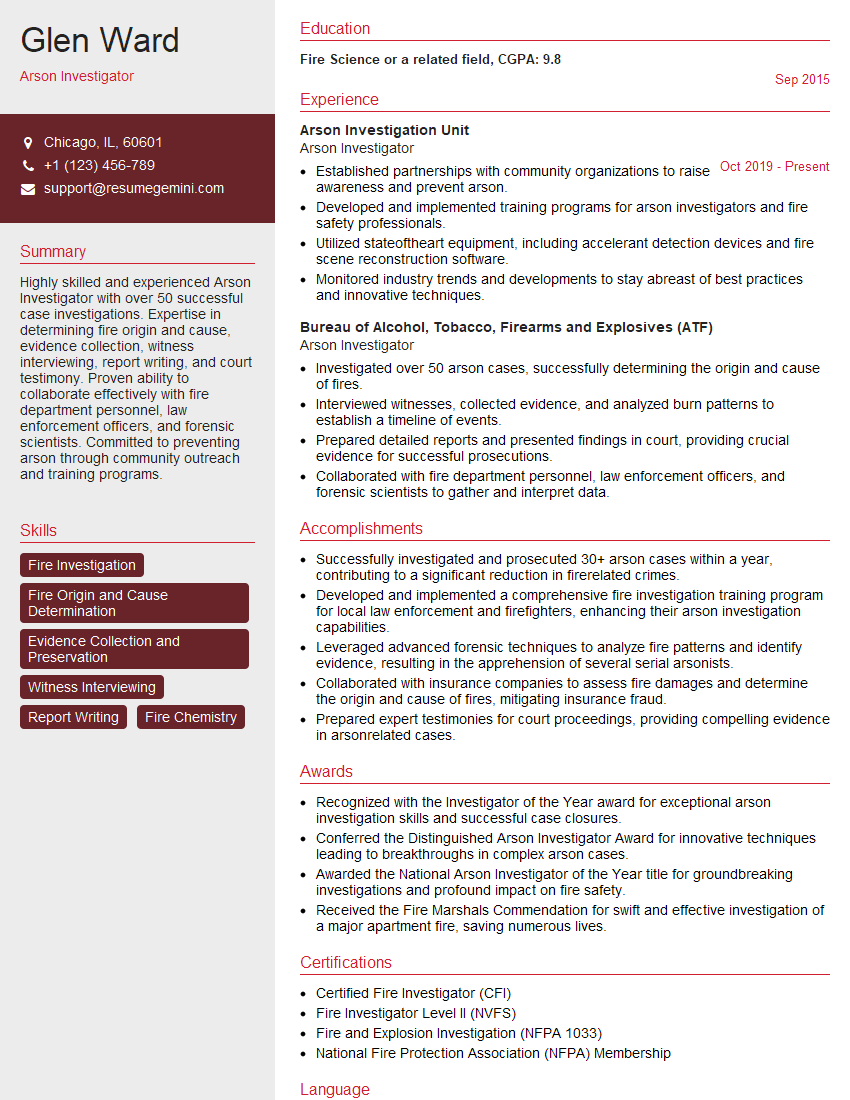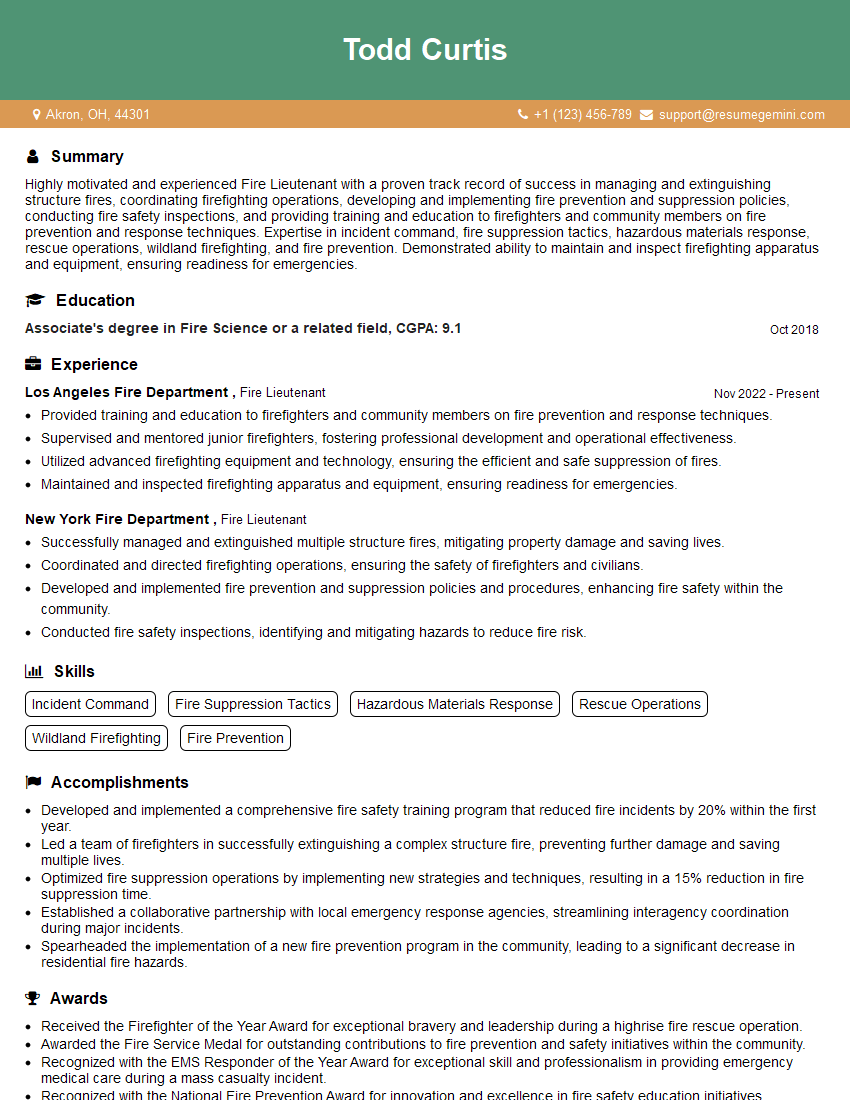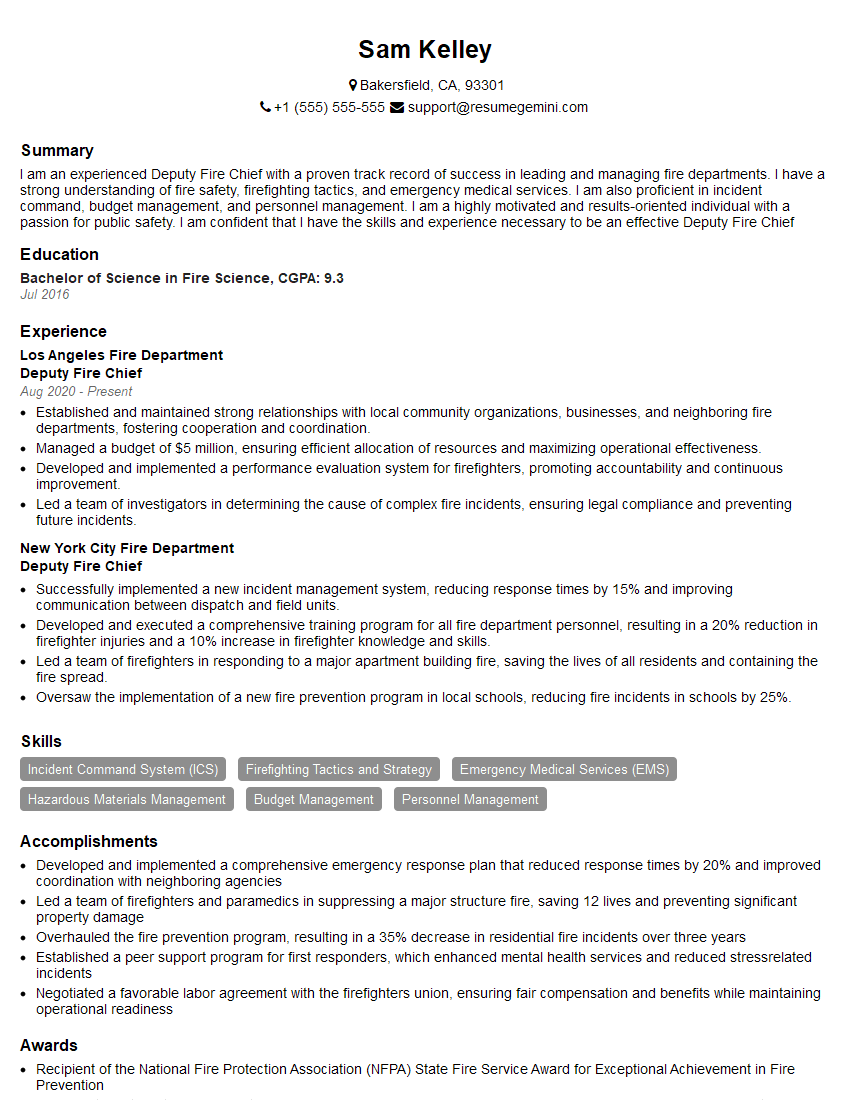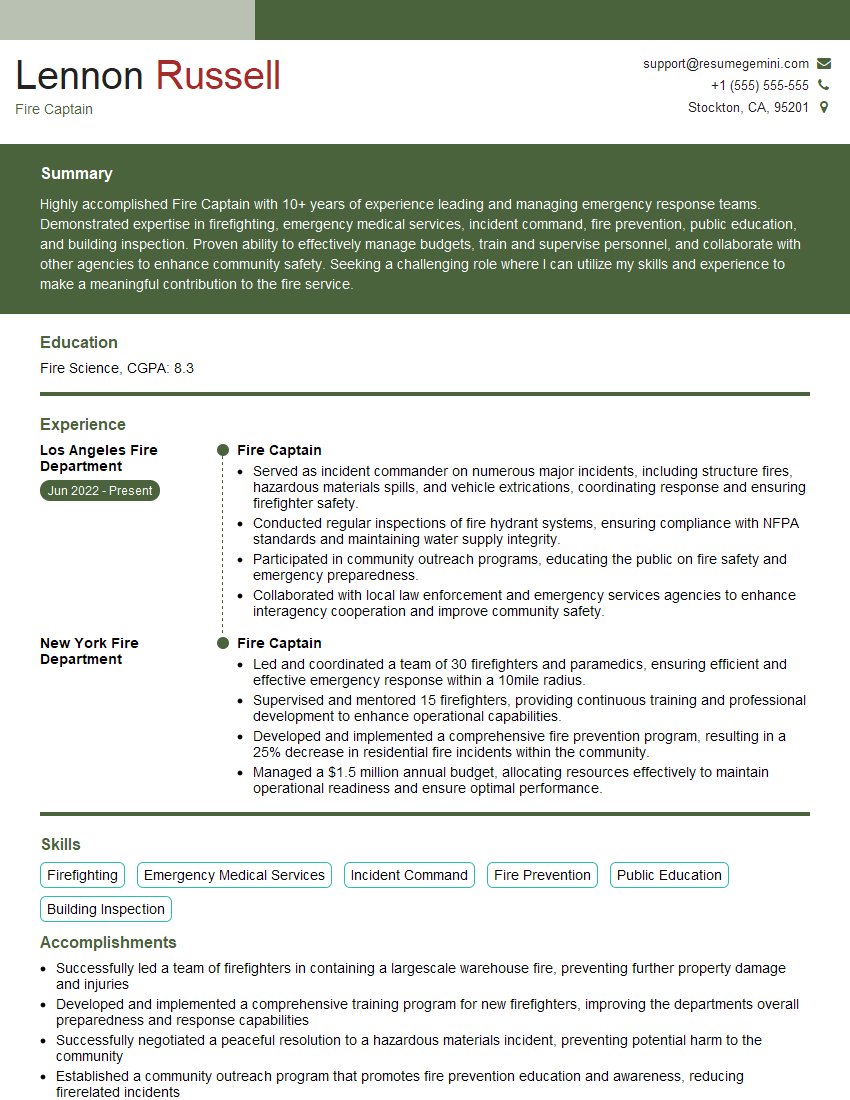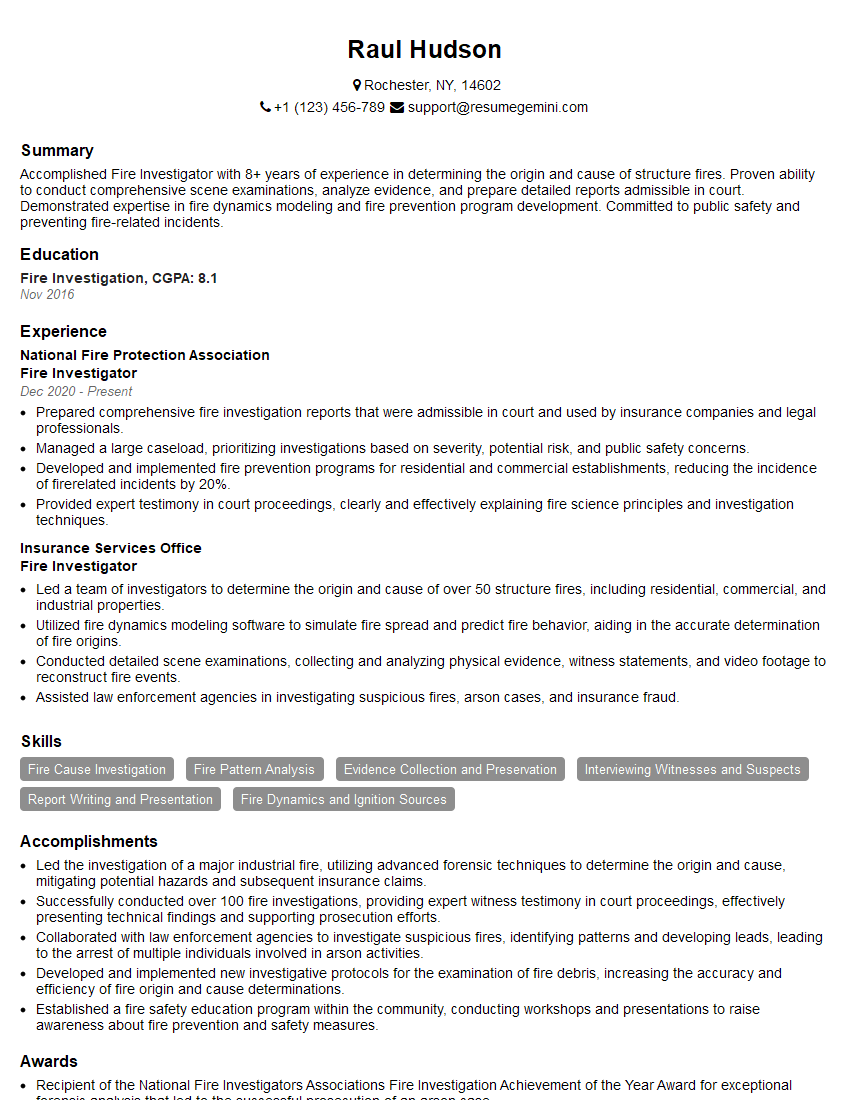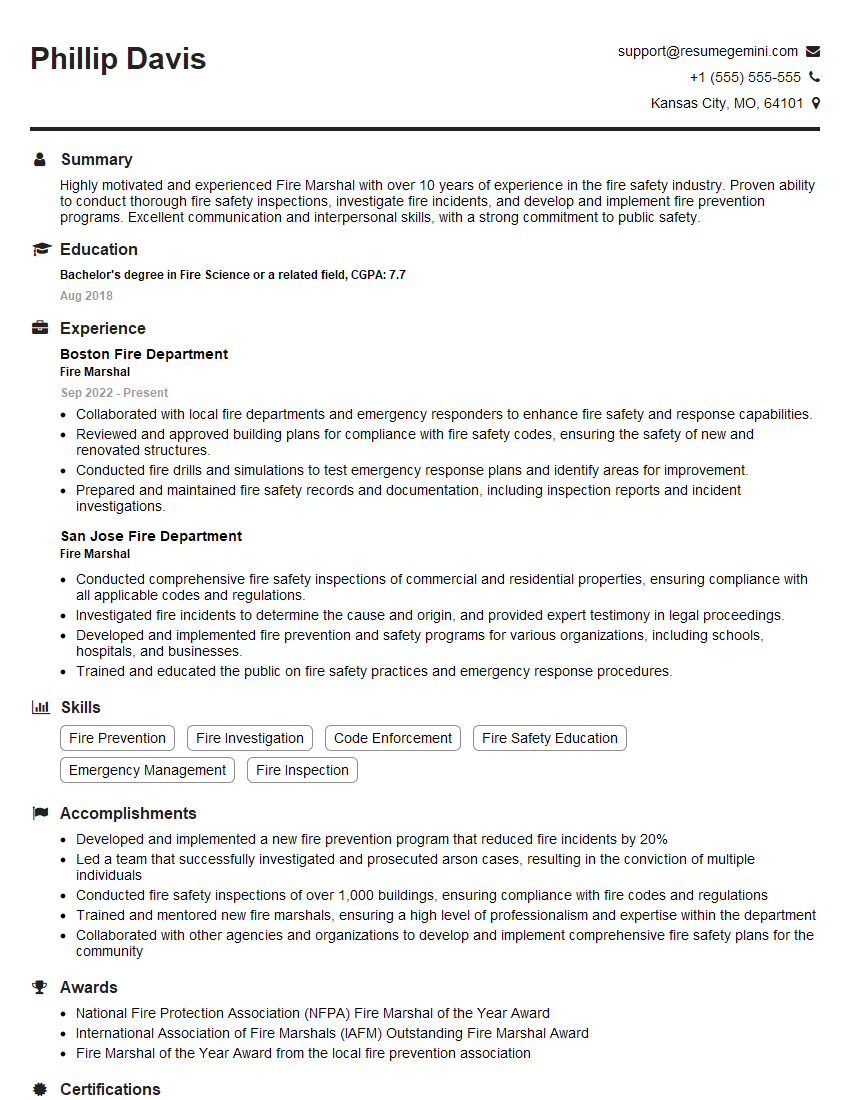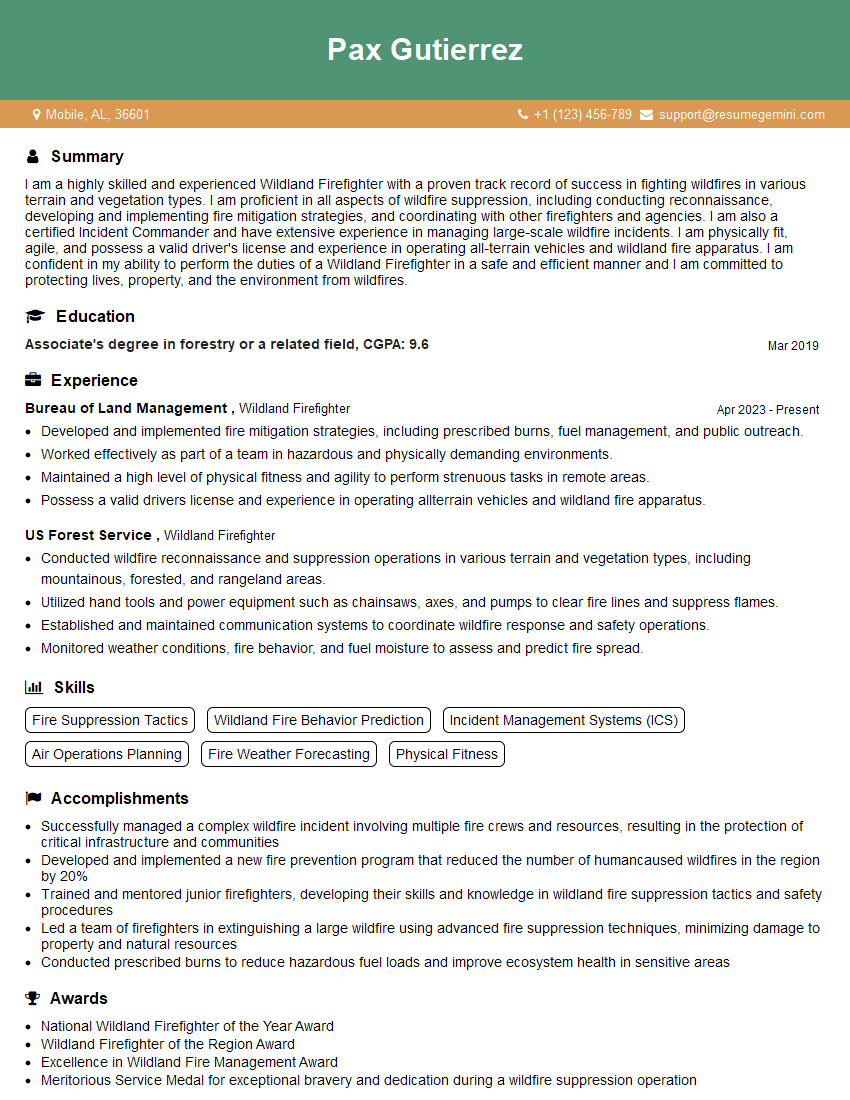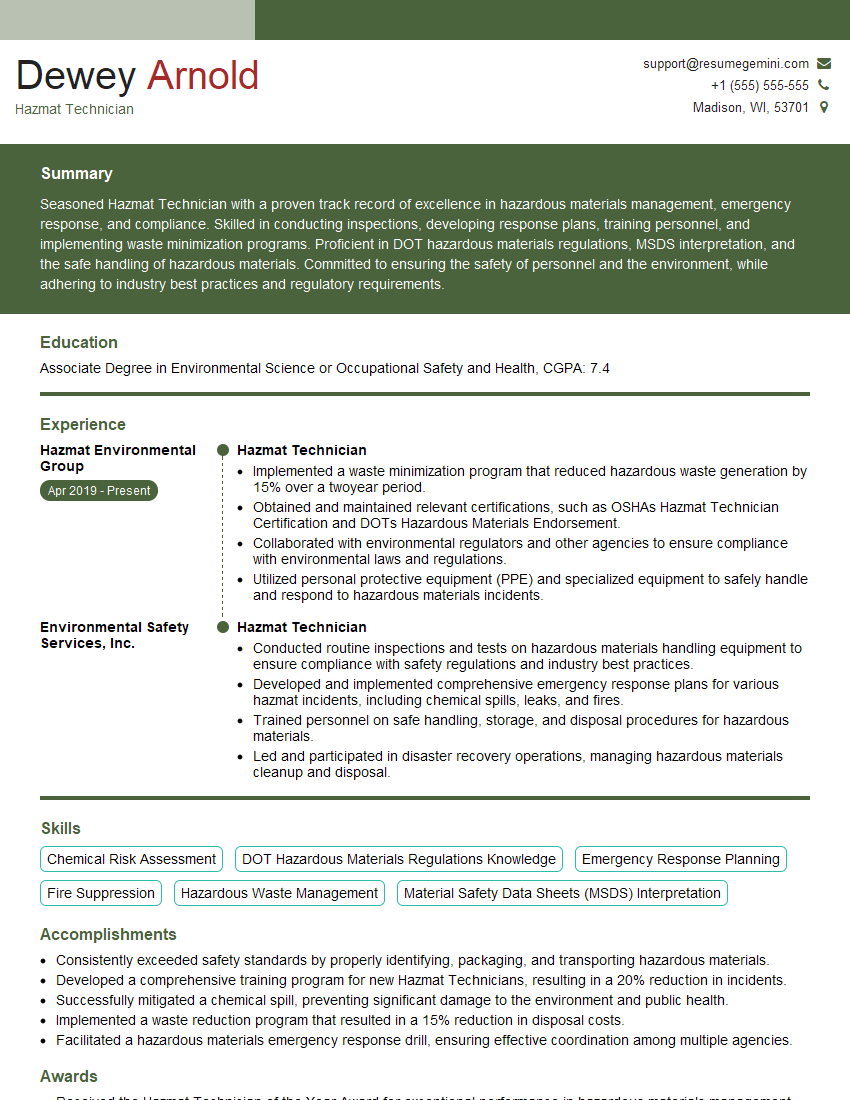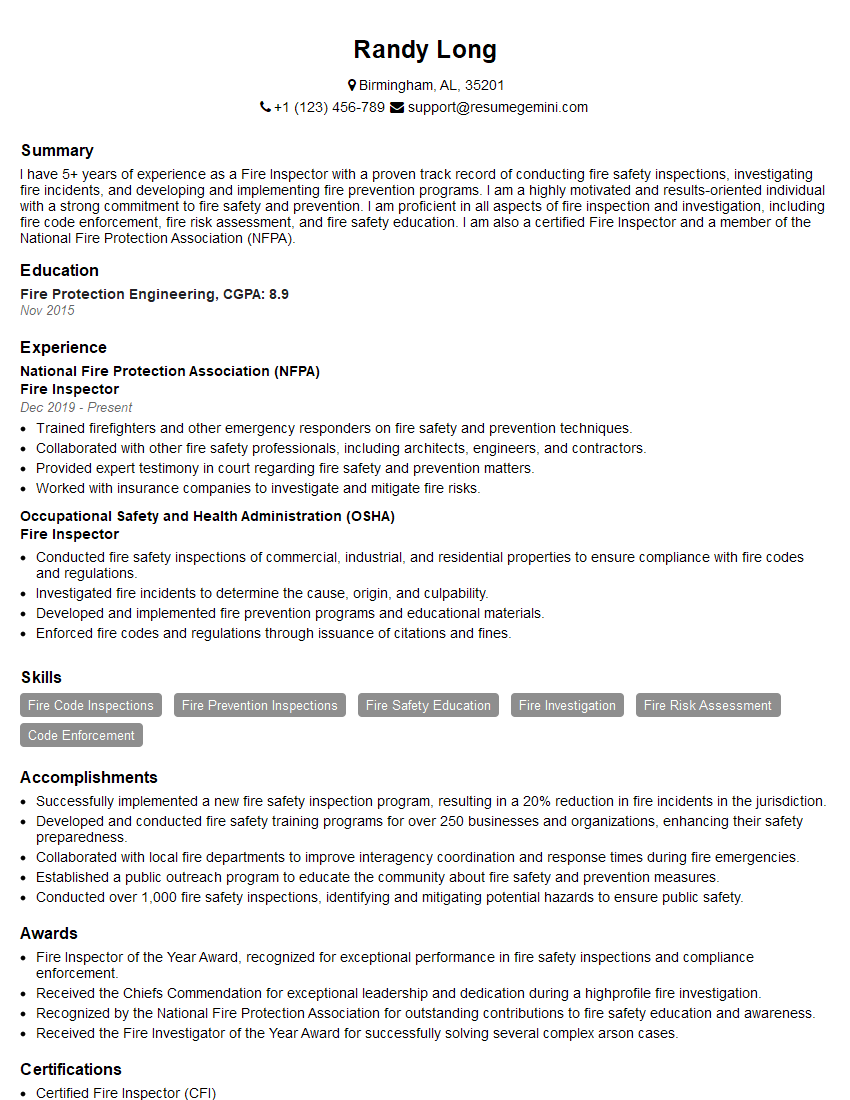Every successful interview starts with knowing what to expect. In this blog, we’ll take you through the top Firefighting Procedures interview questions, breaking them down with expert tips to help you deliver impactful answers. Step into your next interview fully prepared and ready to succeed.
Questions Asked in Firefighting Procedures Interview
Q 1. Describe the different classes of fire and the appropriate extinguishing agents for each.
Fires are classified into different classes based on the type of fuel involved, which dictates the most effective extinguishing agent. Understanding these classifications is crucial for safe and efficient fire suppression.
- Class A Fires: These involve ordinary combustible materials like wood, paper, cloth, and plastics. They are extinguished by cooling the fuel below its ignition temperature. Water is the primary extinguishing agent for Class A fires.
- Class B Fires: These involve flammable liquids like gasoline, oil, grease, and solvents. Extinguishing Class B fires focuses on removing the oxygen supply or interrupting the chemical chain reaction. Suitable agents include carbon dioxide (CO2), dry chemical extinguishers, and foam.
- Class C Fires: These involve energized electrical equipment. The primary hazard here is the risk of electric shock. Never use water on a Class C fire. CO2, dry chemical extinguishers, and Halon (where permitted) are suitable agents. Always de-energize the equipment before attempting suppression if possible.
- Class D Fires: These involve combustible metals such as magnesium, titanium, and sodium. They require specialized extinguishing agents that can prevent the fire from reigniting. Dry powder extinguishers designed specifically for Class D fires are essential.
- Class K Fires: These involve cooking oils and fats in commercial kitchens. Wet chemical extinguishing agents are most effective as they saponify (convert) the fats and oils into a soapy substance, preventing reignition.
Example: A grease fire in a kitchen (Class B) requires a different approach than a burning pile of wood (Class A). Using water on a grease fire could cause it to spread violently.
Q 2. Explain the steps involved in a fireground size-up.
A fireground size-up is a rapid assessment of the situation to develop an effective fire suppression strategy. It’s a crucial first step and is done continuously throughout the incident.
- Life Safety: This is paramount. Assess the immediate threat to life and determine the need for rescue operations.
- Location and Extent of Fire: Identify the area of origin, the size, and the spread of the fire.
- Type of Structure: Understand the building’s construction (wood frame, concrete, etc.), its size, and potential hazards within.
- Available Resources: Assess the available personnel, equipment, and water supply.
- Weather Conditions: Wind, temperature, and precipitation can significantly impact fire behavior.
- Exposures: Identify buildings or areas at risk of fire spread.
- Access and Egress Routes: Determine safe and efficient routes for entry, attack, and evacuation.
Example: Arriving at a fire scene, you might immediately observe heavy smoke from a two-story house, indicating a well-developed fire. Your size-up would involve checking for occupants, determining the best access point, and assessing whether you need additional resources.
Q 3. What are the key components of a fire safety plan?
A comprehensive fire safety plan is critical for minimizing the risk of fire and ensuring the safety of occupants. It should include:
- Emergency Action Plan: A detailed procedure outlining evacuation routes, assembly points, and responsibilities of personnel.
- Fire Prevention Measures: Strategies to reduce the likelihood of fire, such as regular inspections, maintenance of fire suppression systems, and proper storage of flammable materials.
- Fire Detection and Alarm Systems: Installation and maintenance of smoke detectors, heat detectors, and fire alarm systems.
- Fire Suppression Systems: Specifications of fire extinguishers, sprinkler systems, or other suppression technologies, including regular inspection and maintenance schedules.
- Training and Drills: Regular training sessions for occupants on fire safety procedures, evacuation practices, and the use of fire extinguishers.
- Emergency Contacts: A list of emergency contact information for fire departments, medical services, and other relevant authorities.
Example: A fire safety plan for a school would include detailed evacuation routes for each classroom, designated assembly points, and regular fire drills for students and staff.
Q 4. How do you perform a building inspection for fire hazards?
Building inspections for fire hazards require a methodical approach to identify and mitigate potential risks. The process involves:
- Exterior Inspection: Check for proper spacing between buildings, clear access for fire apparatus, and the condition of exterior walls and roofing.
- Interior Inspection: Examine the building’s layout, identify potential fire hazards (flammable materials, blocked exits), and check the condition of fire protection systems.
- Fire Protection Systems: Inspect fire extinguishers, smoke detectors, sprinklers, and fire alarms to ensure they are functioning correctly and are properly maintained.
- Means of Egress: Verify the adequacy and accessibility of exit routes, emergency lighting, and signage.
- Electrical Systems: Check for overloaded circuits, damaged wiring, and the presence of potentially hazardous electrical equipment.
- Heating and Cooking Appliances: Inspect for proper maintenance, clearances, and safe usage practices.
- Flammable Materials: Identify and ensure proper storage of flammable and combustible materials.
Example: During an inspection, you might find blocked exits, malfunctioning smoke detectors, or improperly stored flammable liquids. These issues would be noted and require correction to ensure building safety.
Q 5. Describe your understanding of the NFPA 704 system.
The NFPA 704 standard, also known as the “fire diamond,” is a widely recognized system for communicating the hazards of materials. It uses a diamond shape divided into four sections, each representing a different hazard:
- Health Hazard (Blue): Indicates the potential health effects of the material, ranging from 0 (no hazard) to 4 (severe hazard).
- Flammability Hazard (Red): Indicates the material’s ease of ignition and burning, ranging from 0 to 4.
- Instability Hazard (Yellow): Indicates the material’s instability or reactivity, including its potential to explode or release toxic gases, ranging from 0 to 4.
- Specific Hazard (White): Contains special hazard information, such as oxidizing agents (OX), water reactivity (W), or radioactive materials (RADIOACTIVE).
Example: A fire diamond with a 3 in the red quadrant, a 2 in the blue quadrant, and a 1 in the yellow quadrant indicates a highly flammable material with moderate health hazards and minor instability.
Q 6. Explain the importance of proper ventilation during a fire.
Proper ventilation during a fire is crucial for several reasons. It’s a critical component of fire suppression and influences firefighter and occupant safety.
- Removing Smoke and Toxic Gases: Ventilation removes smoke, heat, and toxic gases, improving visibility and creating a safer environment for firefighters and occupants.
- Controlling Heat and Flames: Ventilation helps control the temperature and spread of the fire by allowing hot gases and smoke to escape.
- Improving Firefighter Visibility: Reduced smoke allows for better visibility and more effective fire suppression.
- Facilitating Fire Attack: Controlled ventilation helps direct the fire attack and prevents the fire from spreading unpredictably.
Example: In a structural fire, a tactical ventilation strategy might involve opening windows and doors to create a controlled flow of air, removing smoke and heat, and allowing firefighters to safely enter and extinguish the fire.
Q 7. What are the different types of fire suppression systems?
Fire suppression systems are designed to automatically or manually extinguish or control fires. Several types exist:
- Water Sprinkler Systems: These are the most common type, using a network of pipes and sprinkler heads to discharge water onto a fire.
- Foam Systems: These systems generate foam to extinguish Class A and Class B fires by suppressing vapor and cooling the fuel.
- CO2 Systems: These systems discharge carbon dioxide, a non-conductive gas that displaces oxygen, effectively extinguishing Class B and Class C fires.
- Dry Chemical Systems: These systems discharge dry chemical agents that disrupt the chemical chain reaction of the fire, effective on Class A, B, and C fires.
- Wet Chemical Systems: Specifically designed for Class K fires (cooking oils and fats), these systems release a potassium-acetate based solution to saponify the grease.
- Halon Systems: These systems (use is now largely restricted due to environmental concerns) utilize Halon gas, which effectively suppresses the chemical chain reaction of the fire.
Example: A large commercial kitchen would likely have a combination of wet chemical and sprinkler systems for comprehensive fire protection.
Q 8. Describe your experience with using SCBA (Self-Contained Breathing Apparatus).
My experience with SCBA (Self-Contained Breathing Apparatus) is extensive. I’ve used them countless times during structural firefighting, wildland firefighting, and hazmat operations. Properly donning and doffing the SCBA is paramount, ensuring a secure seal to prevent inhalation of toxic fumes and smoke. I’m proficient in performing pre-use checks, including air pressure verification, mask fit, and harness adjustments.
During operations, I’m mindful of my air supply, constantly monitoring my gauge to avoid running out of air. This requires careful planning and pacing, especially in low-visibility environments. I understand the importance of buddy breathing procedures in emergency situations and have practiced this technique repeatedly. Finally, post-operation procedures are critical, including cleaning, inspecting, and properly storing the SCBA to ensure its readiness for the next emergency.
For example, during a recent warehouse fire, navigating the thick, black smoke required meticulous attention to my air supply. Maintaining communication with my partner through our SCBA radios was essential for safety and efficient teamwork.
Q 9. How would you handle a situation where a firefighter is injured during an operation?
Responding to a firefighter injury during an operation follows a strict protocol prioritizing the safety of the injured and the ongoing operation. The first step is to immediately call for a mayday, clearly communicating the location, nature of the injury, and the status of the other firefighters.
Simultaneously, we initiate a rapid rescue operation. This might involve a team approaching the injured firefighter, assessing the situation, and employing appropriate rescue techniques depending on the environment and the nature of the injury. The injured firefighter is then immediately removed from the hazardous environment, minimizing further exposure to danger. Once removed, immediate first aid is provided, and the injured firefighter is transported to a hospital for further medical attention. A thorough after-action review is then conducted to identify any factors contributing to the incident, learn from our experiences, and improve future safety protocols.
I remember a situation where a firefighter suffered a sprained ankle during a building collapse. Following our established procedure, we immediately called a mayday, carefully extracted him using a stokes basket, and provided immediate first aid before transporting him to the hospital.
Q 10. What are the common causes of residential fires?
Residential fires are most commonly caused by a combination of factors, often involving human error. The leading causes include:
- Cooking: Unattended cooking is the leading cause of residential fires, often involving grease fires or overheating of cooking appliances.
- Heating equipment: Malfunctioning or improperly installed heating equipment, such as furnaces, space heaters, and fireplaces, can pose significant fire hazards.
- Electrical malfunctions: Faulty wiring, overloaded circuits, and damaged electrical appliances are common causes of electrical fires.
- Smoking materials: Discarded cigarettes or other smoking materials are a significant source of ignition, especially when left unattended near flammable materials.
- Arson: Deliberately set fires can account for a portion of residential fires, although this is often a less frequent cause compared to accidental fires.
It’s important to note that many residential fires result from a combination of these factors and are preventable through proper safety precautions.
Q 11. Explain your understanding of fire spread and containment strategies.
Understanding fire spread is crucial for effective fire containment. Fire spreads through the fire triangle (fuel, heat, oxygen) and can be influenced by several factors. These include:
- Fuel type and availability: The type of material burning, its quantity, and its proximity to other combustible materials influence the speed and intensity of the fire spread.
- Heat transfer: Heat can be transferred through conduction (direct contact), convection (through gases), and radiation (electromagnetic waves), each impacting fire spread in unique ways.
- Ambient conditions: Factors such as wind, humidity, and temperature significantly influence fire spread. High winds can quickly accelerate the spread of a fire, while high humidity can slow it down.
Containment strategies focus on removing one or more elements of the fire triangle. This might involve applying water to cool the fuel and reduce heat, using foam to suppress oxygen, or deploying firebreaks to isolate the fuel source. Strategies vary based on the type of fire (structural, wildland, etc.) and the available resources.
For instance, in a structural fire, we might focus on creating firebreaks by breaching walls and using ventilation tactics to control oxygen levels. In a wildland fire, creating firebreaks by removing fuel, using water drops from air tankers, and deploying fire retardant are important containment strategies.
Q 12. What is your experience with hydraulic rescue tools?
My experience with hydraulic rescue tools, also known as extrication tools, is extensive. These tools, such as spreaders, cutters, and rams, are crucial for rescuing victims trapped in vehicles or other structures. I’m proficient in operating these tools safely and effectively, understanding the importance of proper technique to avoid injury to both rescuers and victims.
My training includes understanding the hydraulic systems, proper maintenance procedures, and recognizing potential hazards associated with using these powerful tools. I’m familiar with the various accessories available and can adapt my approach based on the specific rescue situation. Safety is paramount, and I always prioritize the well-being of both the victim and my rescue team when using these tools. We conduct regular training exercises, practicing different rescue scenarios to ensure we’re prepared for any eventuality.
For example, I’ve successfully used spreaders to remove a vehicle’s door during a car accident to free a trapped passenger. The precise application of pressure, as well as good communication with the rescue team, was vital in achieving this.
Q 13. Describe the different types of fire hoses and their applications.
Fire hoses are crucial for delivering water to suppress fires, and different types are designed for various applications. Common types include:
- 1 ½-inch hoses: Often used for smaller fires or as attack lines by smaller crews.
- 2 ½-inch hoses: These are larger capacity hoses used for larger fires requiring higher water volume, such as structural fires.
- Booster hoses: Shorter, smaller diameter hoses used by initial attack crews or for smaller incidents.
- Supply lines (Larger diameter): Used to relay water from a hydrant or water source to the attack lines.
The choice of hose depends on the specific situation – the size of the fire, water pressure, and accessibility to the fire. Proper hose handling, including advancing, deploying, and retracting, is crucial for effective firefighting and the safety of the crew.
Q 14. Explain your familiarity with incident command systems (ICS).
Incident Command Systems (ICS) are standardized management tools used for controlling emergency incidents. My familiarity with ICS is comprehensive. I understand its organizational structure, including the roles of the Incident Commander, Operations Section Chief, Planning Section Chief, Logistics Section Chief, and Finance/Administration Section Chief.
I know how to effectively communicate within the ICS structure, using clear, concise language and established protocols. I’m experienced in using ICS forms and documentation to track progress and resource allocation during an incident. This includes utilizing the ICS-201 (Incident Briefing) and ICS-214 (Resource Status) forms. Understanding ICS ensures efficient resource management, coordination among different agencies, and a structured response that promotes safety and effectiveness.
For example, during a large-scale forest fire, ICS proved vital in coordinating efforts between different fire departments, air support, and other agencies, facilitating a well-organized and effective response.
Q 15. What is your understanding of the role of risk assessment in firefighting?
Risk assessment in firefighting is crucial for minimizing danger to firefighters and the public. It’s a systematic process of identifying hazards, analyzing their risks, and developing control measures. Think of it as a pre-fire plan that dictates how we will approach a specific incident.
We assess factors like building type (wood frame is riskier than concrete), fire location, presence of hazardous materials, and potential for structural collapse. For example, if we’re dealing with a suspected gas leak alongside a fire, our risk assessment would prioritize securing the gas line before aggressive interior attack. This involves understanding the potential for explosions and adjusting our tactics accordingly.
The process typically involves a team effort, combining the experience of senior firefighters with up-to-date information gathered on-site. We utilize various tools and techniques, such as pre-incident planning maps and building surveys, to enhance accuracy and efficiency in the risk assessment.
Career Expert Tips:
- Ace those interviews! Prepare effectively by reviewing the Top 50 Most Common Interview Questions on ResumeGemini.
- Navigate your job search with confidence! Explore a wide range of Career Tips on ResumeGemini. Learn about common challenges and recommendations to overcome them.
- Craft the perfect resume! Master the Art of Resume Writing with ResumeGemini’s guide. Showcase your unique qualifications and achievements effectively.
- Don’t miss out on holiday savings! Build your dream resume with ResumeGemini’s ATS optimized templates.
Q 16. Describe your experience in conducting post-incident analysis.
Post-incident analysis (PIA) is an essential part of continuous improvement. It’s a structured review of what happened during a fire, identifying successes, failures, and areas for enhancement. Think of it as a retrospective, not a blame game.
My experience involves leading and participating in numerous PIAs. We typically gather the crew involved, review radio traffic, analyze photographs and videos, and assess damage. We objectively discuss factors such as response time, initial actions, resource deployment, and communication effectiveness. We use a systematic approach, often following a formal incident reporting format.
For instance, in one incident, our PIA revealed a communication breakdown between the interior and exterior teams. This led to revised standard operating procedures (SOPs) to improve inter-team communication, which ultimately led to smoother operations during subsequent emergencies.
Q 17. How would you manage a situation involving a hazardous materials spill?
Managing a hazardous materials (HAZMAT) spill demands a structured approach emphasizing safety and containment. The first priority is to establish a perimeter and evacuate the area, ensuring public safety.
Next, we identify the spilled material—this often requires specialist HAZMAT teams equipped with identification kits. Understanding the material’s properties (flammability, toxicity, reactivity) is crucial for choosing appropriate containment and decontamination procedures. We may employ methods like damming, absorption, or dilution, depending on the specific hazard and environmental conditions.
Communication is key, both internally within the response team and externally with emergency management agencies, hospitals, and other stakeholders. We would utilize specialized equipment such as respirators, protective suits, and specialized containment tools. Effective communication and adherence to established HAZMAT protocols would ensure a safe and effective resolution.
Q 18. What safety procedures do you follow when operating fire apparatus?
Safety when operating fire apparatus is paramount. This includes pre-trip inspections to ensure functionality of all systems, including lights, sirens, brakes, and the pump. Drivers must be extensively trained and adhere to strict traffic regulations.
We follow protocols like using seatbelts at all times, maintaining safe following distances, and never exceeding safe speeds. We are also extensively trained in emergency vehicle operations, including safe navigation through congested areas and understanding the behavior of the vehicle under different conditions.
Furthermore, we practice regular vehicle maintenance, follow all safety protocols for loading and securing equipment on the apparatus and conduct thorough post-incident checks to detect any damage or needed repairs.
Q 19. Describe your understanding of fire codes and regulations.
Fire codes and regulations are essential for preventing fires and ensuring life safety. My understanding covers building codes, fire prevention codes, and occupational safety and health administration (OSHA) standards.
These codes dictate aspects of building construction, fire alarm systems, sprinkler systems, and emergency exits. They also specify requirements for fire prevention measures, such as proper storage of flammable materials and regular inspections. Compliance ensures a safe environment and limits the risk of significant fire incidents.
I’m familiar with the nuances of different codes relevant to various building types and occupancy classifications. For instance, I’m aware of the stricter requirements for high-rise buildings concerning fire suppression and evacuation strategies.
Q 20. How would you communicate effectively during a fire emergency?
Effective communication during a fire emergency is critical for coordinating actions, ensuring safety, and achieving a positive outcome. Clear and concise communication, utilizing both verbal and written methods, is vital.
We utilize radio communication within the team, relaying critical information about the incident’s progression, hazards encountered, and resource needs. Standard operating procedures dictate how information is conveyed – clear and concise, avoiding jargon where possible. We also communicate effectively with dispatch, providing regular updates on the situation.
Incident command systems (ICS) are critical for managing large incidents. They provide a structured framework for assigning roles, ensuring clear lines of authority, and facilitating effective communication across multiple teams. This prevents confusion and allows for a coordinated response.
Q 21. Explain your experience with using thermal imaging cameras.
Thermal imaging cameras (TICs) are invaluable tools that allow us to see through smoke and locate hidden fire sources. They detect infrared radiation, showing temperature differences and allowing us to identify hot spots and victims trapped within a burning structure.
My experience with TICs includes using them for search and rescue operations, locating the seat of a fire for more effective extinguishment, assessing structural integrity, and verifying complete extinguishment after a fire.
For example, in one instance, we used a TIC to locate a victim trapped beneath debris in a collapsed building. The TIC allowed us to see through the smoke and debris, enabling a targeted rescue that saved a life. It’s not just a tool; it’s a life-saving technology that greatly improves our capabilities.
Q 22. What are the signs of potential arson?
Identifying potential arson requires a keen eye for detail and understanding of fire behavior. It’s not about simply seeing fire, but recognizing patterns suggestive of deliberate ignition. Several key indicators can point towards arson:
- Multiple points of origin: Fires that start in several separate locations strongly suggest arson. A naturally occurring fire usually has a single point of origin.
- Unusual accelerants: The presence of flammable liquids like gasoline, kerosene, or other chemicals can be a strong indicator. Fire investigators look for traces of these substances.
- Evidence of forced entry: If there’s evidence of forced entry into a building, this could suggest arson for malicious purposes, such as insurance fraud or vandalism.
- Suspicious circumstances: This includes things like a recent dispute, financial troubles, or unusual activity around the time of the fire. Witness testimonies are crucial here.
- Delayed ignition: A fire that starts significantly after an apparent triggering event (e.g., a short circuit) might be suspicious.
- Unusual burn patterns: Patterns that don’t match typical fire behavior, like ‘pour patterns’ from accelerants, raise red flags.
For example, finding gasoline trails leading to several points of ignition in a building is a clear sign of arson. A fire investigator would collect samples of these accelerants for lab analysis to confirm their presence and type. The information gathered helps build a case for investigation.
Q 23. How do you ensure the safety of civilians during a fire evacuation?
Ensuring civilian safety during a fire evacuation involves a multi-pronged approach focusing on clear communication, efficient guidance, and a well-rehearsed plan. This begins long before an incident occurs.
- Pre-planning and drills: Regular fire drills, including building-specific evacuation plans, are critical. People need to know their designated assembly points and escape routes.
- Clear and consistent communication: Using loudspeakers, megaphones, and clear visual signals (e.g., flashing lights) ensures everyone receives directions. This is particularly important for individuals with disabilities.
- Designated personnel: Trained personnel should be assigned to guide people, especially those who might need assistance, such as the elderly or people with mobility challenges.
- Accountability: A system for tracking who has evacuated is vital to ensure no one is left behind. This could involve roll calls at assembly points.
- Emergency exits: Maintaining clear access to emergency exits is essential. Regular inspections ensure they remain unobstructed.
- Communication with emergency services: Maintaining clear communication with the fire service allows for coordinated evacuation and rescue efforts.
Imagine a high-rise building fire. A well-coordinated evacuation involving floor wardens guiding residents to designated staircases, with firefighters stationed at key points to assist, would drastically improve safety and reduce the risk of casualties.
Q 24. What is your understanding of the different types of smoke and their significance?
Smoke is a critical indicator in firefighting. Its color, density, and even smell can provide valuable clues about the type of material burning and the intensity of the fire. Different types of smoke offer distinct insights:
- White smoke: Often indicates a fire in its early stages, involving materials like wood or paper. It’s typically less dense and less dangerous than other types.
- Gray smoke: Suggests smoldering materials like damp wood or textiles. It may still be relatively safe, but can quickly become more dangerous as the fire intensifies.
- Black smoke: This dense, dark smoke indicates a hot, intense fire involving materials like plastics or rubber. It contains a high concentration of toxic gases and is very hazardous.
- Brown smoke: Similar to black smoke, this often signifies burning wood, but it also indicates a slower, smoldering fire.
- Yellow or orange smoke: Indicates the presence of burning hydrocarbons (plastics, oils etc.) and is highly toxic.
For instance, seeing black smoke billowing from a building would immediately indicate a serious fire requiring swift and aggressive intervention, necessitating the use of appropriate protective gear and respiratory apparatus. The color and density of smoke helps firefighters assess the situation and choose their tactics.
Q 25. Describe your experience working as part of a team in a high-pressure environment.
Working as part of a team in high-pressure firefighting environments is paramount. It’s not just about individual skill, but about coordinated action and clear communication under extreme stress. My experience includes countless scenarios where trust and teamwork were vital to success.
During a large warehouse fire, our team faced intense heat and zero visibility. Our captain clearly communicated the strategy – one team for interior attack, another for exterior support, and a third for backup and rescue. We followed established protocols, relying on each member’s expertise. Clear radio communication ensured constant situational awareness. Despite the chaos, our teamwork resulted in containment and the safe evacuation of personnel. This illustrates the importance of well-defined roles, trust, and relentless adherence to procedures.
Q 26. How would you deal with a confined space rescue situation?
Confined space rescue is inherently dangerous, requiring specialized equipment and training. It begins with a thorough risk assessment, followed by meticulous planning and execution.
- Pre-entry checks: The atmosphere inside must be tested for toxic gases (oxygen deficiency, carbon monoxide etc.) and flammables before entry. Atmospheric monitoring equipment is crucial.
- Ventilation: Establishing proper ventilation is crucial to reduce hazards and improve visibility.
- Personal protective equipment (PPE): Firefighters must wear appropriate PPE, including self-contained breathing apparatus (SCBA), specialized suits, and harnesses.
- Entry and rescue techniques: Techniques like low-profile entry and the use of specialized rescue equipment like tripod systems for hoisting are critical.
- Communication: Maintaining constant communication with the team inside and outside the confined space is essential.
- Backup teams: Having a backup rescue team ready is mandatory in case of emergencies inside the confined space.
For example, rescuing someone trapped in a collapsed sewer system demands using specialized ropes, harnesses, and breathing apparatus. Each step needs to be coordinated precisely due to the risk of further collapses or exposure to hazardous materials.
Q 27. What are your strengths and weaknesses related to firefighting procedures?
My strengths lie in my calm demeanor under pressure, my strong decision-making skills, and my proactive approach to safety. I’m adept at assessing situations quickly and efficiently, and I am always focused on maintaining clear communication within the team. My extensive experience ensures quick adaptation to various emergency situations.
A weakness, if I had to identify one, would be my tendency to be perfectionistic. In high-pressure scenarios, this can sometimes lead to slight delays. However, I actively work to balance thoroughness with efficiency, making sure my attention to detail doesn’t hinder critical time-sensitive decisions.
Q 28. Describe a time you had to make a quick, critical decision in a fire emergency.
During a residential fire, I encountered a situation where rapid decision-making was crucial. We arrived to find heavy smoke and flames engulfing the second floor. Initial reports indicated a trapped child. While the incident commander focused on establishing the water supply, I quickly assessed the situation, identifying a secondary access point – a slightly opened window on the ground floor.
Given the critical time constraint and the risk of further structural collapse, I decided to bypass the main entry and attempt rescue through the window. My team and I quickly gained access, locating and rescuing the child, minimizing exposure to the flames. The immediate action saved the child’s life, illustrating the importance of risk assessment, adaptability, and decisive action in critical moments.
Key Topics to Learn for Firefighting Procedures Interview
- Fire Behavior and Combustion: Understanding the fire triangle, stages of fire development, and factors influencing fire spread. Practical application: Analyzing a fire scene to determine appropriate suppression strategies.
- Fire Suppression Techniques: Mastering various extinguishing methods (water, foam, dry chemical, CO2), including their advantages and limitations. Practical application: Selecting the optimal suppression method based on the type of fire and available resources.
- Personal Protective Equipment (PPE): Knowing the proper use, inspection, and maintenance of all PPE, including SCBA operation and limitations. Practical application: Demonstrating the ability to correctly don and doff PPE in a simulated emergency.
- Building Construction and Fire Spread: Understanding how different building materials and designs influence fire behavior and escape routes. Practical application: Identifying potential hazards and escape routes in various building types.
- Incident Command System (ICS): Familiarity with ICS principles and roles, including communication protocols and incident management. Practical application: Describing your role and responsibilities within an ICS structure during a large-scale incident.
- Emergency Vehicle Operation and Safety: Understanding safe driving procedures, emergency vehicle operation, and responding to emergency calls safely and efficiently. Practical application: Demonstrating knowledge of defensive driving techniques and emergency response protocols.
- Hazardous Materials Awareness: Basic understanding of hazardous materials identification, handling procedures, and safety precautions. Practical application: Recognizing common hazardous materials and outlining appropriate response actions.
- Rescue Techniques: Knowledge of various rescue techniques, including confined space rescue, high-angle rescue, and water rescue. Practical application: Describing appropriate rescue procedures based on different scenarios.
- Post-Incident Procedures: Understanding post-incident procedures, including scene cleanup, equipment maintenance, and incident reporting. Practical application: Detailing the steps involved in securing a fire scene after extinguishing a fire.
Next Steps
Mastering Firefighting Procedures is crucial for career advancement in this demanding field. It demonstrates a commitment to safety, expertise, and professionalism, opening doors to leadership roles and specialized units. To maximize your job prospects, create an ATS-friendly resume that highlights your skills and experience effectively. ResumeGemini is a trusted resource that can help you build a professional resume that stands out. Examples of resumes tailored to Firefighting Procedures are available to guide you, ensuring your application makes a powerful first impression.
Explore more articles
Users Rating of Our Blogs
Share Your Experience
We value your feedback! Please rate our content and share your thoughts (optional).
What Readers Say About Our Blog
Hello,
We found issues with your domain’s email setup that may be sending your messages to spam or blocking them completely. InboxShield Mini shows you how to fix it in minutes — no tech skills required.
Scan your domain now for details: https://inboxshield-mini.com/
— Adam @ InboxShield Mini
Reply STOP to unsubscribe
Hi, are you owner of interviewgemini.com? What if I told you I could help you find extra time in your schedule, reconnect with leads you didn’t even realize you missed, and bring in more “I want to work with you” conversations, without increasing your ad spend or hiring a full-time employee?
All with a flexible, budget-friendly service that could easily pay for itself. Sounds good?
Would it be nice to jump on a quick 10-minute call so I can show you exactly how we make this work?
Best,
Hapei
Marketing Director
Hey, I know you’re the owner of interviewgemini.com. I’ll be quick.
Fundraising for your business is tough and time-consuming. We make it easier by guaranteeing two private investor meetings each month, for six months. No demos, no pitch events – just direct introductions to active investors matched to your startup.
If youR17;re raising, this could help you build real momentum. Want me to send more info?
Hi, I represent an SEO company that specialises in getting you AI citations and higher rankings on Google. I’d like to offer you a 100% free SEO audit for your website. Would you be interested?
Hi, I represent an SEO company that specialises in getting you AI citations and higher rankings on Google. I’d like to offer you a 100% free SEO audit for your website. Would you be interested?
good
